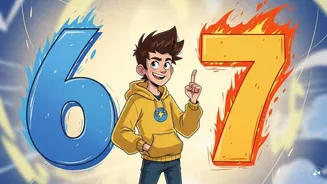Case in point: children hollering the numbers ‘6-7’, pronounced as 'six-seveeeeen', across school halls in the United States, the United Kingdom and even Australia. The trend has become so prevalent that schools have even begun to ban the phrase, citing it to be a menace.
While the name suggests numbers, there’s no math involved. Decoding what it actually means, though? That’s proving almost as tricky.
The viral ‘6-7’ trend
In recent times, educators and parents alike have been complaining that tweens and teens are shouting out the term “6-7,” accompanied by a ‘juggling’ hand gesture.
As Gabe Dannenbring, a seventh-grade science teacher in South Dakota told CNN, “It’s like a plague — a virus that has taken over these kids’ minds. You can’t say any iteration of the numbers six or seven without having at least 15 kids yell, ‘6-7!’”
But where did this trend emerge from? The internet blames American rapper Skrilla for it; the number appears in the chorus of Doot Doot (6 7). Some believe the numbers in the song is a reference to the 10-67 police code, which is often used to report a death.) But there’s no confirmation on that.

The 6-7 trend derives from the song "Doot Doot (6 7)" by rapper Skrilla which features the recurring lyric, “6-7.” Image Courtesy: Skrilla/Instagram
Soon after the song released, US high school basketball star Taylen Kinney appeared to create a gesture to accompany the phrase. Shortly thereafter, Kinney started incorporating the song and gesture into his TikToks, where he has over one million followers.
Soon, sports highlight reels and social media creators began using the sound, spreading it further.
It’s been referenced in a recent episode of the four-time Emmy winning series Abbot Elementary and was the entire plot of South Park’s first episode of season 28.
Meaning behind the viral ’67’ trend
But what does it mean when children yell out the two words? That’s still up in the air.
According to some teens, it can be used as a casual descriptor to say something is “so-so,” refer to someone who is tall, or simply as a joke without a punchline.
As one teacher noted, “Nobody knows what it means. And that’s kind of the funny thing about it.”
Even 13-year-old Desarie Alvarez, an eighth grade associate student body president at Giano Intermediate, told The Times the phrase has been creating a playful buzz around the campus and playground for the past couple of months. The phrase “6-7” is random, she said, but her classmates find it funny nonetheless. “I don’t really see how it’s funny but, I got used to it,” she said.

There's no meaning attached to the '6-7' trend. Students shout it when a teacher mentions the numbers six or seven, or even for no reason at all. Image used for representational purposes
But even though it’s random and pretty much meaningless, this phrase is serving a social function, note many child experts. Taylor Jones, a linguist and social scientist, told CNN that the phrase is a shibboleth, or a phrase that signifies that one belongs to an “in” group.
Gail Fairhurst, a University of Cincinnati professor specialising in leadership communication, explains that the phrase functions as a language game where participation signals membership in an exclusive group.
As Jennifer Wills Lamacq, a child psychologist, told
“Six seven is ideal because it is totally meaningless. It can’t be explained — you either know or you don’t, you’re in or you’re out.”
Teachers unamused by 6-7 trend
But while kids may enjoy it and find it funny, the 6-7 trend has become a headache for many teachers at schools, calling it a distraction in class.
Adria Laplander, a sixth-grade language arts teacher in Michigan, told Today.com, “I’ve been teaching for 20 years and I’ve dealt with all sorts of slang — nothing has driven me crazier than this one.”
New Jersey fourth-grade teacher Monica Choflet was quoted as telling The Independent that the slang “6-7” has become so common in her class that students shout it whenever they hear a six or a seven. “I could say, ‘It’s 1:16 pm, time for class and someone says, ‘67!’”

Some teachers in the US and the UK have banned students from saying the term “6-7,” a nonsensical expression often blurted out. Representational image/Pixabay
Alex Turnham, who teaches maths at a primary school in Kent, also complains of the trend disrupting his classes. “I have had to change all my lessons to remove any reference to six or seven,” he told
Even TikTok is flooded with videos of kids saying the numbers “six, seven,” or descending into a frenzy when they hear someone else say it, with more than two million posts using the hashtag #67.
And with students showing no signs of wanting to stop with this trend, teachers are adapting; they are either joining the bandwagon or going on the defence, banning the words — six or seven.
One teacher in the US is making her students write ‘I will not say ‘67’ in class’ — six times for a first offence, seven for a second, and 67 for a third.
But other teachers have decided that if you can’t beat them, join them. A parent was quoted as telling the New York Post that her fifth grade daughter’s teacher counts up to five and then waits for the kids to continue counting with ‘six…seven’ and then they all laugh.
As Gabe Dannenbring said to CNN, “If you don’t play into it, yeah, it’s super disruptive. If you acknowledge it, then it gets over with in about 15 seconds.”
With inputs from agencies















